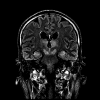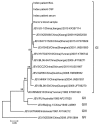Japanese Encephalitis Virus Transmitted Via Blood Transfusion, Hong Kong, China
- PMID: 29043965
- PMCID: PMC5749455
- DOI: 10.3201/eid2401.171297
Japanese Encephalitis Virus Transmitted Via Blood Transfusion, Hong Kong, China
Abstract
Japanese encephalitis virus (JEV) is a mosquitoborne virus endemic to China and Southeast Asia that causes severe encephalitis in <1% of infected persons. Transmission of JEV via blood transfusion has not been reported. We report transmission of JEV via blood donation products from an asymptomatic viremic donor to 2 immunocompromised recipients. One recipient on high-dose immunosuppressive drugs received JEV-positive packed red blood cells after a double lung transplant; severe encephalitis and a poor clinical outcome resulted. JEV RNA was detected in serum, cerebrospinal fluid, and bronchoalveolar lavage fluid specimens. The second recipient had leukemia and received platelets after undergoing chemotherapy. This patient was asymptomatic; JEV infection was confirmed in this person by IgM seroconversion. This study illustrates that, consistent with other pathogenic flaviviruses, JEV can be transmitted via blood products. Targeted donor screening and pathogen reduction technologies could be used to prevent transfusion-transmitted JEV infection in highly JEV-endemic areas.
Keywords: China; Japanese encephalitis virus; asymptomatic; blood transfusion; encephalitis; immunocompromised host; infection control; packed red blood cells; platelets; vector-borne infections; viral encephalitis; viruses.
Figures



Similar articles
-
mosGCTL-7, a C-Type Lectin Protein, Mediates Japanese Encephalitis Virus Infection in Mosquitoes.J Virol. 2017 Apr 28;91(10):e01348-16. doi: 10.1128/JVI.01348-16. Print 2017 May 15. J Virol. 2017. PMID: 28250133 Free PMC article.
-
Virulence of Japanese Encephalitis Virus Genotypes I and III, Taiwan.Emerg Infect Dis. 2017 Nov;23(11):1883-1886. doi: 10.3201/eid2311.161443. Emerg Infect Dis. 2017. PMID: 29048288 Free PMC article.
-
Serological Prevalence Against Japanese Encephalitis Virus-Serocomplex Flaviviruses in Commensal and Field Rodents in South China.Vector Borne Zoonotic Dis. 2016 Dec;16(12):777-780. doi: 10.1089/vbz.2015.1934. Epub 2016 Nov 9. Vector Borne Zoonotic Dis. 2016. PMID: 27828763
-
Potential for the emergence of Japanese encephalitis virus in California.Vector Borne Zoonotic Dis. 2009 Oct;9(5):511-7. doi: 10.1089/vbz.2008.0052. Vector Borne Zoonotic Dis. 2009. PMID: 18973447 Review.
-
Mosquito Vector Competence for Japanese Encephalitis Virus.Viruses. 2021 Jun 16;13(6):1154. doi: 10.3390/v13061154. Viruses. 2021. PMID: 34208737 Free PMC article. Review.
Cited by
-
Arboviral Risk Associated with Solid Organ and Hematopoietic Stem Cell Grafts: The Prophylactic Answers Proposed by the French High Council of Public Health in a National Context.Viruses. 2023 Aug 22;15(9):1783. doi: 10.3390/v15091783. Viruses. 2023. PMID: 37766192 Free PMC article. Review.
-
Dengue Virus Infection of Blood-Brain Barrier Cells: Consequences of Severe Disease.Front Microbiol. 2019 Jun 26;10:1435. doi: 10.3389/fmicb.2019.01435. eCollection 2019. Front Microbiol. 2019. PMID: 31293558 Free PMC article. Review.
-
The effect of infectious diseases on lung transplantation in Japan.J Thorac Dis. 2024 Feb 29;16(2):1632-1644. doi: 10.21037/jtd-22-1884. Epub 2024 Feb 27. J Thorac Dis. 2024. PMID: 38505071 Free PMC article. Review.
-
Research advancements in the neurological presentation of flaviviruses.Rev Med Virol. 2019 Jan;29(1):e2021. doi: 10.1002/rmv.2021. Epub 2018 Dec 12. Rev Med Virol. 2019. PMID: 30548722 Free PMC article. Review.
-
Neuroinvasion of emerging and re-emerging arboviruses: A scoping review.SAGE Open Med. 2024 May 6;12:20503121241229847. doi: 10.1177/20503121241229847. eCollection 2024. SAGE Open Med. 2024. PMID: 38711470 Free PMC article.
References
Publication types
MeSH terms
LinkOut - more resources
Full Text Sources
Other Literature Sources
Medical
Molecular Biology Databases

